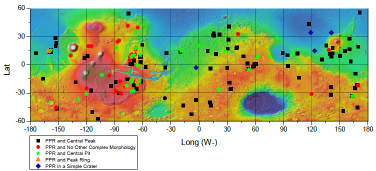Geophysicist and planetary scientist Jason Nycz uses Origin to analyze the morphology and rheology of impact craters on Mars.He uses Origin to statistically catalogue craters by type and location, and to integrate crater profile data in a process known as palinspastic restoration, which is a method of reconstructing the morphology of a crater over time. Location plan-view maps, histograms, and area-fill plots are generated using Origin's built-in graph templates.
Craters have formed on the surface of Mars and other planets through collisions with meteorites and comets. This process began over 4 billion years ago, and continues today. High resolution image and topographic data of the present-day Martian surface is collected from instruments aboard orbiting satellites. A model accounting for initial impact and subsequent surface morphology is applied to determine the most likely initial crater shape.
Once the restored crater model is complete, Jason uses Origin to plot cross-sections of craters both at present (based on Digital Elevation Models derived from Satellite data) and at various stages of the crater’s evolution (based on the palinspastical model). He then uses Origin's Integrate Gadget (introduced in Origin 8.5) to find the unit volume of regions between the two curves, which represent differences in crater morphology at two instances in time. He is currently researching ways to take this analysis into three dimensions with the help of Origin's volume integration method. |
|

Locations of impact craters by crater-type on the surface of Mars
|
| |
Graph showing unit volume
conservation for Peripheral Peak ring (PPR) generation. Using the
integration gadget in Origin 8.5, unit volumes for various topographical
elements were calculated. Because unit volume must be conserved before,
during and after PPR formation, the shape and position of material
through the process is well constrained.
|